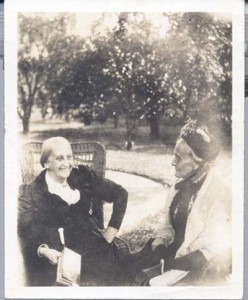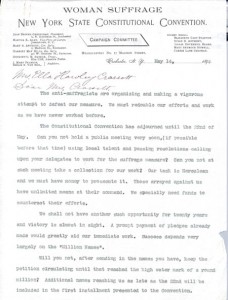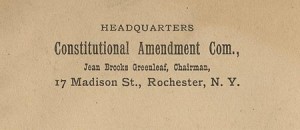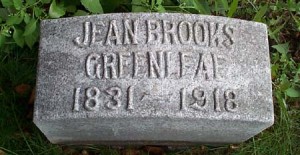 Born October 1, 1831
Born October 1, 1831
Birthplace Bernardston, MA
Died 1918
Grave Site Mt. Hope Cemetery, Rochester, NY
Contribution A leader in the suffrage movement
Jean Brooks was born in Bernardston (Franklin County), Massachusetts on October 1, 1831. Her father, John Brooks, was a doctor. Her mother, Mary Bascom Brooks, was a homemaker. She had five older siblings who lived to adulthood.
Jean Brooks was educated in Bernardston’s public schools and at a local academy prior to enrolling in the Melrose Seminary in West Brattleboro, Vermont. Her stay at the seminary was cut short after only two terms, when a decline in her mother’s health necessitated her return home in order to take over management of the family household.
In 1862, Jean Brooks married Halbert S. Greenleaf. Prior to his marriage, Mr. Greenleaf, a native of Vermont, had moved to Massachusetts, where he had organized the Yale and Greenleaf Lock Company, been a justice of the peace (1856) and was a captain in the state’s militia (1857).
Mr. Greenleaf enlisted in the Union Army the same year that the couple married, and within a short time he became a colonel in the Massachusetts volunteers. During the 1860s the couple also lived for a time near New Orleans, Louisiana where Mr. Greenleaf was employed in a salt works.
In 1867, the Greenleafs moved to Rochester, New York and Mr. Greenleaf resumed his employment as lock manufacturer. This employment was interrupted by his two terms as a Democrat in the U.S. Congress –1883 to1885, and again from 1891 to 1893.
 Jean Brooks Greenleaf was an active Rochester clubwoman and community organizer. She chaired the organizational meeting of the Women’s Ethical Club (WEC), an association inspired by Mary Gannett and formed in 1889 so that members might discuss issues of ethics and philanthropy. Greenleaf also chaired the committee that drafted the constitution of the Woman’s Educational and Industrial Union (WEIU). The WEIU, an organization which provided activities and services for working women, was initiated by Mary Gannett and Susan B. Anthony in 1893. Rochester’s WEIU offered classes in homemaking, childcare and stenography, a lecture program, an employment bureau, a lounge and lunchroom, and legal services. In 1893, Greenleaf was also a member of the committee that organized and raised money for the Domestic Science Department of the Mechanic’s Institute (later to become Rochester Institute of Technology).
Jean Brooks Greenleaf was an active Rochester clubwoman and community organizer. She chaired the organizational meeting of the Women’s Ethical Club (WEC), an association inspired by Mary Gannett and formed in 1889 so that members might discuss issues of ethics and philanthropy. Greenleaf also chaired the committee that drafted the constitution of the Woman’s Educational and Industrial Union (WEIU). The WEIU, an organization which provided activities and services for working women, was initiated by Mary Gannett and Susan B. Anthony in 1893. Rochester’s WEIU offered classes in homemaking, childcare and stenography, a lecture program, an employment bureau, a lounge and lunchroom, and legal services. In 1893, Greenleaf was also a member of the committee that organized and raised money for the Domestic Science Department of the Mechanic’s Institute (later to become Rochester Institute of Technology).
Greenleaf is mainly remembered for her work as a suffragist leader. Shortly after her husband’s first term in Congress, she joined the Women’s Political Club (later to become the Political Equality Club), which had been organized by Mary Anthony and others in late 1885 and early 1886. Greenleaf became its second president in May, 1888.
Greenleaf soon became a statewide leader in the suffrage cause. She was elected to the presidency of the New York State Woman Suffrage Association (NYSWSA) at a state convention held in Rochester (NY) in December, 1890. During her first year in office, reports indicated that membership in the organization had doubled.
 During the first years of her presidency, Greenleaf was active in or spoke at a number of local, statewide and national events, including the Western New York Fair held in Rochester on September 23, 1891, annual NYSWSA conventions and National American Woman Suffrage Association (NAWSA) conventions. On February 17, 1892, she was among the delegates from twenty-six states who addressed a suffrage hearing held by the House Judiciary Committee of the U.S. Congress.
During the first years of her presidency, Greenleaf was active in or spoke at a number of local, statewide and national events, including the Western New York Fair held in Rochester on September 23, 1891, annual NYSWSA conventions and National American Woman Suffrage Association (NAWSA) conventions. On February 17, 1892, she was among the delegates from twenty-six states who addressed a suffrage hearing held by the House Judiciary Committee of the U.S. Congress.
From December 1893 to July 1894, Greenleaf was tirelessly involved in what was known as the Second New York Campaign for women’s suffrage. This campaign was organized from its headquarters in the Anthony home on Madison Street. Ida Husted Harper tells us that here, women “worked day and night…sending out thousands of letters, petition blanks, leaflets, suffrage papers….,” and that Greenleaf “came every day” and “toiled without ceasing from daylight till dark….” During that time, Greenleaf, along with Susan B. Anthony, also addressed the Suffrage Committee of New York State’s Constitutional Convention in Albany’s Assembly Chamber (May 24, 1894). During June, 1894, Greenleaf presided when the Suffrage Committee heard five-minute remarks from suffragists representing their districts throughout the State (excluding New York City).
During 1894, Greenleaf was nominated by the Democrats in her district as the only woman delegate to the state’s constitutional convention. In September 1894, she appeared before the resolutions committees of both the Democratic and Republican State Conventions in Saratoga, presenting the case for women’s suffrage. Greenleaf also addressed the 1894 NAWSA convention, detailing the work of the Campaign.
Greenleaf reappeared at the 1895 NAWSA convention in Atlanta, Georgia to report on the Campaign’s defeat:
We had the satisfaction of knowing that the [state constitutional convention] delegates…were kept upon a strong equal suffrage diet for days and nights together….At the close of the last we learned that there were in this convention ninety-eight men who dared to say that the freemen of the State should not be allowed to decide whether their wives, mothers and daughters should be enfranchised or not. We learned also, that there were fifty-eight men, constituting a noble minority, who loved justice better than party power, and were willing to risk the latter to sustain the former.
Greenleaf stepped down from the presidency of the state association at NYSWSA’s annual convention in 1896. After her term as president, she remained active for the cause. She was a member of the NYSWSA’s legislative committee in 1901, and during the NYSWSA convention in Oswego held the same year, she offered a memorial testimonial for Charlotte A. Cleveland, a suffragist from Wyoming County.
Greenleaf’s community and suffrage activities were enhanced by her friendship with Susan B. Anthony. During the spring of 1891, when Anthony decided to return home to Madison Street and live with her sister, Mary Anthony, the Political Club over which Greenleaf presided raised $250 to help refurnish the house, and Greenleaf introduced 300 guests at a housewarming held on June 11, 1891.
Anthony’s diary gives insight on their personal friendship during the early 1890s:
Just before noon Mrs. Greenleaf popped into the woodshed with a great sixteen-quart pail full of pound balls of the most delicious butter, and we made her stay to dinner. The Girl was washing and I got the dinner alone: broiled steak, potatoes, sweet corn, tomatoes and peach pudding, with a cup of tea.
On New Year’s Day, 1895, the Greenleafs were among a small group of friends invited to the Anthony home to celebrate. Greenleaf was one of those who addressed the guests gathered for the seventy-sixth birthday celebration of Susan B. Anthony in 1896. She again addressed guests for Anthony’s eighty-fifth birthday celebration in 1905.
 In 1906 Greenleaf was dealt a double blow, first with the death of her friend Anthony and then with the death of her husband, who died in their summer home in Greece, New York on August 26th. In 1907, Greenleaf had the comfort of knowing that her husband was memorialized as a friend of suffrage at the NAWSA Convention. During the same year she addressed a crowd gathered at Rochester’s African Methodist Episcopal (A.M.E.) Zion Church for the unveiling of a stained glass window memorial for Anthony. Her 1907 testimonial on the death of Mary Anthony is recorded in Ida Husted Harper’s Life and Work of Susan B. Anthony.
In 1906 Greenleaf was dealt a double blow, first with the death of her friend Anthony and then with the death of her husband, who died in their summer home in Greece, New York on August 26th. In 1907, Greenleaf had the comfort of knowing that her husband was memorialized as a friend of suffrage at the NAWSA Convention. During the same year she addressed a crowd gathered at Rochester’s African Methodist Episcopal (A.M.E.) Zion Church for the unveiling of a stained glass window memorial for Anthony. Her 1907 testimonial on the death of Mary Anthony is recorded in Ida Husted Harper’s Life and Work of Susan B. Anthony.
Bibliography of Suggested Books & Articles
- Dow, Harriet Brown, “Influence of Women in the Life of Rochester,” in Centennial History of Rochester, New York, Vol. II, Home Builders, Edward R. Foreman, comp. & ed., Rochester NY: 1932.
- Harper, Ida Husted, The Life and Work of Susan B. Anthony, (Harper), Indianapolis & Kansas City: The Hollenbeck Press, 1908. v. II & III>
- Harper, Ida Husted, editor, History of Woman Suffrage, Rochester, NY, Susan B. Anthony, 1902, v. IV.
- Harper, Ida Husted, editor, History of Woman Suffrage, National American Woman Suffrage Association, 1922, v. VI.
- McKelvey, Blake, “Woman’s Rights in Rochester: A Century of Progress” Rochester History, v. X, Nos. 2 & 3 (July 1948).
- Willard, Frances E., and Mary A. Livermore, eds., (Willard) A Woman of the Century, Buffalo: Charles Wells Moulton, 1893, Republished by Gale Research Co., Book Tower, Detroit, 1967, pp. 339-40.